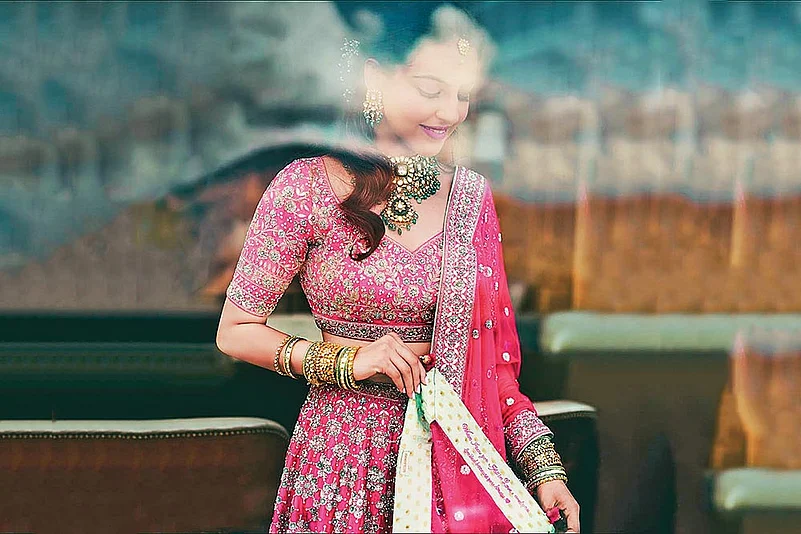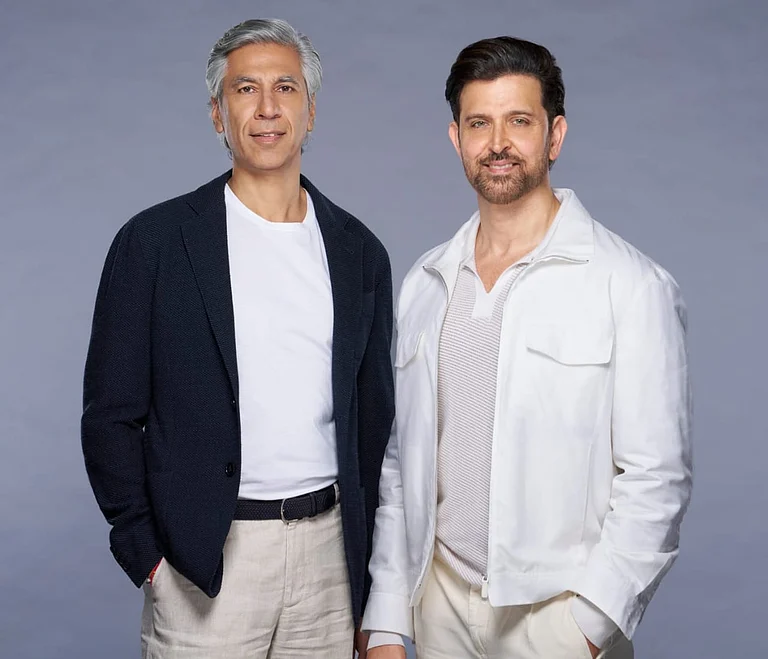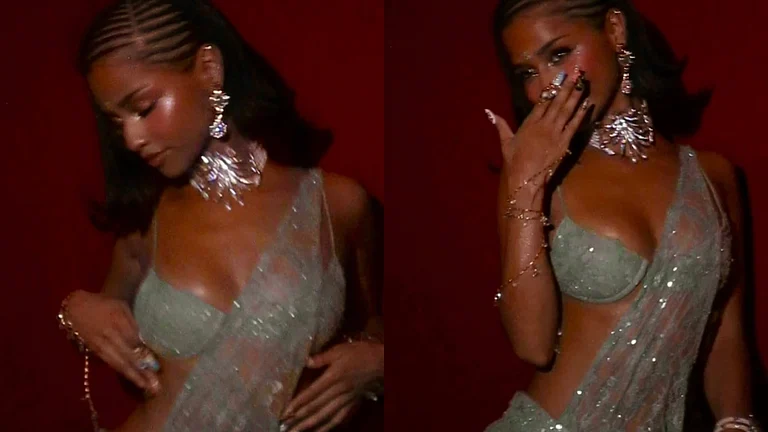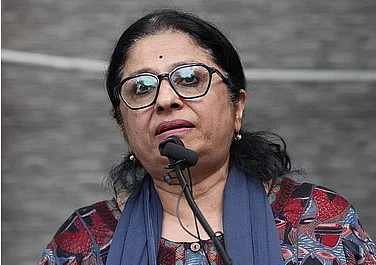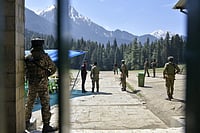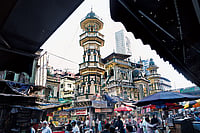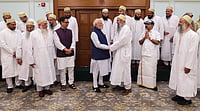The glittering Manish Malhotra lehenga, worn by Radhika Merchant—the Ambani family’s youngest daughter-in-law—for one of the pre-wedding soirees in Jamnagar, Gujarat, was a feast for the eyes of fashionistas. Adorned with gold and silver motifs, the designs were embossed with 300,000 Swarovski crystals and took 5,700 hours (roughly 7 months) to craft to perfection. Actor Sonam Kapoor Ahuja’s red and gold lotus motif lehenga embroidered using the Kalabattu technique by designer Anuradha Vakil, worn in the simple wedding at home, is now archived as a showpiece of Indian handicrafts at the Nita Mukesh Ambani Cultural Centre (NMACC) in Mumbai. And Deepika Padukone’s Sabyasachi dress for the Sindhi wedding at Lake Como in Italy, bearing the Sanskrit quote ‘Sada Saubhagyavati Bhava’ on the dupatta border is now a piece of Instagram lore.
Bridal wear is no longer just the dress worn for the traditional ceremony but has gone extravagant with custom-made couture conceptualised by the country’s leading designer brands, to be hard launched on the wedding day. From established fashion houses like Tarun Tahilani, Sandeep Khosla and Abu Jani to contemporary designers like Masaba and Rahul Mishra, the bigwigs of the Indian fashion industry are dipping their pens in bridal couture to craft exclusive designs ranging anywhere from Rs 50,000 to prices that are revealed only on request.
With roughly 32 lakh weddings taking place during the season, the Indian bridal wear or wedding apparel industry is reportedly amongst the fastest-growing markets. It is estimated to be worth over Rs 70,000 crore and stands second only to the United States on a global scale. India is a key player in the international wedding market that stands at 61.1 billion USD and is projected to grow to 83.5 billion USD by 2030, as per the latest forecast by ResearchandMarkets.com.

But it is not just the rich celebrities, Bollywood stars, or acclaimed names in the art and culture world who are spending millions for the coveted bridal couture. The new-age brides in India and the diaspora are aspiring to make their weddings eternal by donning bridal wear that reflects their style and tells their story.
Benaisha Kharas, a Zoroastrian living in Mumbai envisioned dressing up in a baby pink French Chantilly lace saree for her big day, just like her mother did for her wedding. An elegant white embroidered saree with a heavy border is an attire of choice among the Parsi brides for the simple ‘lagan’ ceremony. Kharas, instead went on to wear half a dozen custom-made bridal pieces, including a signature lehenga in gara style, embodying her Parsi culture, a lehenga painted in Pichwai art with birds and flowers embracing her love for nature, and a hot pink lehenga with heart motifs and a dupatta embossed with the Shakespeare quote, “When I saw you, I fell in love, and you smiled because you knew.”
Both high-end designer brands and commercial markets are raking in the moolah. Wedding fashion is a major catalyst for shaping the fashion landscape of the country.
The bespoke bridal couture, entirely handcrafted from the House of Anita Dongre label, perfectly captured the young image consultant’s femininity and love for the sublime and has become a proud part of her heirloom collection. “I was always going to wear Anita Dongre’s creations even if I were not marrying her son. There were no two ways about it,” Kharas said with a giggle.
Fashion designer Anita Dongre left no bead stones, pearls, and sequins unturned for her daughter-in-law’s wedding trousseau. But the label has been adopting the same tenacity and exclusivity when it comes to dressing other brides since establishing its recent bridal line, says Yash Dongre, President of the House of Anita Dongre label and Kharas’ husband.
The fashion house has been synonymous with revolutionising pret wear, by giving a contemporary twist to Indian wear. Its designs went viral after the Duchess of Cambridge Kate Middleton wore the long tunic dress while playing cricket in Mumbai during her 2017 tour to India. Her designs have since been seen on international celebrities, including Beyonce, the Jonas Brothers, Hillary Clinton, and Ivanka Trump.
Dongre’s label decided to step into bridal wear a decade ago, after many of its clients began to inquire about wedding couture in their signature style. “Our focus has always been on functionality and comfort. While most designs in the markets at the time were traditionally beautiful, the brides were uncomfortable carrying the extremely heavy lehenga choli.”
The label broke the monotony of heavy wedding couture by featuring light-weight lehengas, which retained the traditional style and handcrafted designs, but also come with pockets, a hands-down ‘comfort’ deal breaker for any millennial bride. “The bridal line has elevated our brand equity. If one wants to be taken seriously as a couture designer, in the Indian market you have to do bridal wear. It’s a must,” Dongre said. The bridal line contributes to 50% of the annual output of the Anita Dongre label besides pret and luxury couture.
Bridal wear constitutes 10-12%— a significant component of the total clothes market in India, according to the Clothing Manufacturers Association of India (CMAI), which represents 4000 garment manufacturers. The wedding season lasting approximately 30 days has become the principal sales period for several manufacturers of the garment industry including fashion designers. In the post-pandemic years, the market for traditional wear has seen a major boom with Indian families spending more than 32% of the total spending on clothing for auspicious days or celebratory functions. Add to that a dose of Bollywood weddings, which have become a major influence on the younger generation and dictate trends in mass fashion.
In a major cultural shift, bridal wear ended the dominance of traditional reds and green, to define the millennial bride’s style in dreamy pastels. Designer Samant Chauhan, who once created bridal wear in only regal off-white and ivory tones, found very few buyers. “The bride’s family would think it was inauspicious to wear dull colours for wedding celebrations. They preferred the bright red and pink. But pastels have become a new favourite especially after several Bollywood actors began wearing them,” he said. The choice of pastel lehengas and sarees by Anushka Sharma, Alia Bhatt, Pareeniti Chopra, Katrina Kaif and Kiara Advani has led to a higher demand for lighter embroideries and pastels not just in India but also abroad.
Blown away by Chauhan’s designs, a royal family of Qatar turned up at his workshop in Delhi’s Shahpur Jat locality— an urban village housing designer boutiques and fashion stores—in 20 Mercedes to buy bridal wear. “At first I thought it was an elaborate prank but they ended up buying nearly 18 dresses for the bride and the family. We custom-made a 44 metre-long trail for the main dress,” he said.
Not just the high-end designer brands, even commercial markets are raking in the moolah. Wedding fashion has become a major catalyst for shaping the overall fashion landscape of the country and dominates a significant component of the commercial market.
Rahul Mehta, chief mentor, CMAI, feels the revival of Indian thinking has been a significant marker in increasing the value of wedding wear. Earlier, weddings would be a one-day affair for the middle class and grooms would opt for Western wear, mostly blazer jacket or suits, says Mehta. “For Indian men, wearing Indian clothes like kurta pyjama was seen as simple dressing, which many avoided as it was socially looked down upon. Weddings would be the occasions to wear formal tie-suits.”
The introduction of affordable Indian ethnic designer wear in the commercial market by brands like Manyawar, Roopam, etc, offering a range of styles at affordable prices has been a game-changer for menswear. Now the entire baarat, guests and families wear desi clothes for occasions like sangeet and traditional ceremonies.
MORE FROM THIS ISSUE
More men and women, whether the bride and groom or their families are investing money in buying commercial wedding wear, including sarees, lehenga cholis, jackets and kurtas. According to Mehta, bridal wear has contributed to a massive turnover for commercial retail brands. “Surprisingly, even more than big designers. The wedding wear designs are now less ostentatious, and economical, which makes it more appealing to younger buyers. You can’t repeat a Sabyasachi dress anywhere other than at your own wedding, but you can wear high-end dresses from retail brands multiple times on different occasions. It is more than just a bridal trousseau.”






